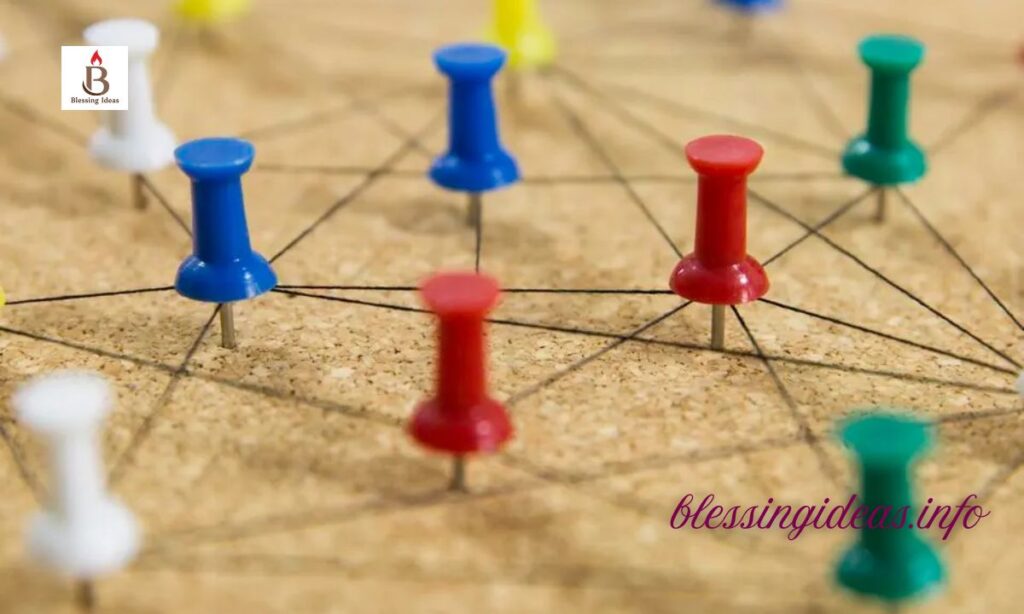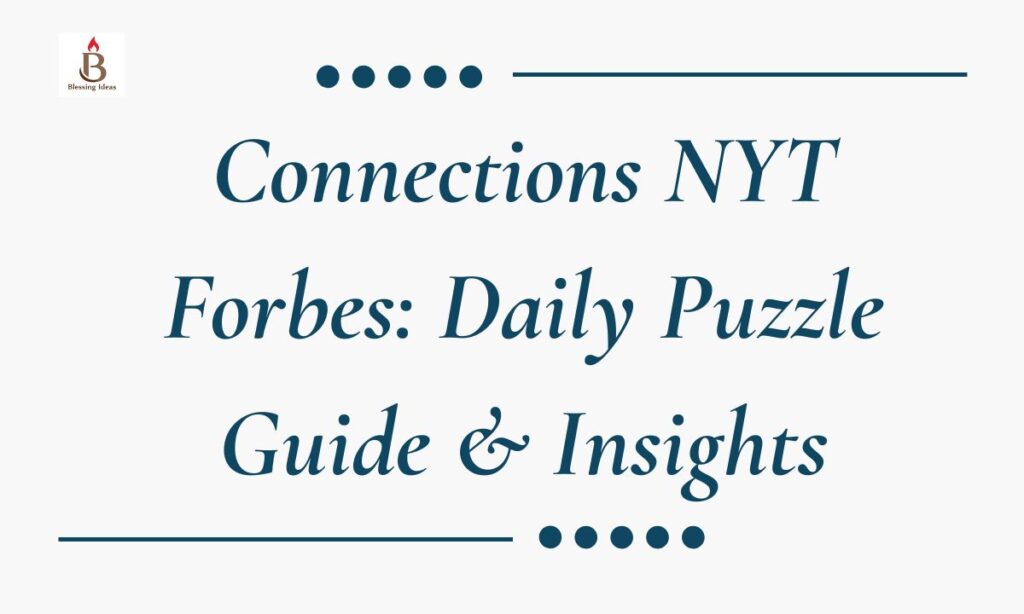The NYT Connections puzzle has become a daily favorite for millions of word game lovers. Forbes now provides expert guides to help players solve these challenging puzzles every day. Each puzzle presents 16 words that must be grouped into four categories.
Forbes offers smart hints and strategies without spoiling the fun. Their daily coverage helps both beginners and expert solvers improve their skills. This perfect combination of puzzle creativity and expert guidance makes Connections an essential part of morning routines worldwide.
What Are Connections NYT Forbes?
Connections is a daily word puzzle published by The New York Times. Players receive 16 words and must group them into four categories. Each category contains exactly four related words that share a common theme.
Forbes provides daily coverage with hints, strategies, and answers for each puzzle. Their articles appear every morning when the new puzzle drops. This reliable schedule helps players start their day with expert guidance.
Breaking Down the Connections Puzzle Phenomenon
The puzzle presents a simple premise with complex execution. Sixteen words appear on your screen in a grid format. Your job is to find the hidden connections between them.
Each puzzle has four difficulty levels shown by colors. Yellow categories are straightforward and easy to spot. Green and blue offer moderate challenges with wordplay and synonyms. Purple categories twist your brain with obscure connections and creative thinking.
Why Forbes Covers This Puzzle Daily
Forbes readers are professionals who value mental sharpness and daily challenges. The Connections puzzle fits perfectly into their morning routines. It provides quick cognitive exercise before the workday begins.
The publication saw an opportunity to serve their audience better. Their readers were already playing the puzzle every day. Forbes decided to provide expert guidance that matched their editorial standards.
How the NYT Connections Puzzle Took Over Forbes Readers
The puzzle launched quietly but spread like wildfire through social media. Forbes readers discovered it through shared emoji grids on Twitter and LinkedIn. The professional crowd quickly embraced this smart, shareable challenge.
Business leaders and executives found the puzzle perfect for mental warm-ups. It takes just a few minutes but delivers satisfying cognitive stimulation. The challenge level matches the intelligence of Forbes’ target audience.
Forbes noticed their readers discussing the puzzle in comments and social posts. They responded by creating comprehensive daily coverage. This move strengthened their connection with readers and established Forbes as the go-to puzzle resource.
The Viral Moment That Changed Everything
Social media transformed Connections from a niche puzzle into a cultural phenomenon. Players started sharing their results using colored emoji squares. These spoiler-free grids showed your solving path without revealing answers.
The sharing format was genius because it sparked friendly competition. Friends could compare their solving strategies visually. This created organic marketing that traditional advertising could never achieve.
Psychology Behind the Addiction
The puzzle triggers powerful dopamine releases when you solve categories correctly. Your brain rewards pattern recognition with pleasure chemicals. This creates a positive feedback loop that keeps you coming back.
The daily format builds anticipation and habit formation. Your brain knows a new puzzle arrives at midnight. This consistency creates a ritual that becomes part of your routine.
Step-by-Step Guide to Solving Connections NYT Forbes Puzzles
Start by reading all 16 words without clicking anything. This overview helps you spot obvious patterns. Rushing leads to wasted mistakes on early wrong guesses.
Look for the easiest category first, usually indicated by yellow. These straightforward connections build confidence and preserve your mistake allowance. Common themes include colors, animals, or professions.
Work through green and blue categories next using logical elimination. Save the tricky purple category for last when you have fewer words. This strategic approach maximizes your chances of solving the entire puzzle.
Your First Look at the 16-Word Grid
Take a deep breath and scan all words carefully. Don’t let your eyes fixate on words sitting next to each other. The visual arrangement is random and often misleading. Look for words that seem completely out of place.
- Read all 16 words twice before clicking anything
- Look for obvious patterns like colors, animals, or professions
- Identify words that seem completely out of place
- Notice words with multiple meanings or uses
- The visual arrangement is random and often misleading
Starting With Yellow Categories
Yellow categories reward straightforward thinking and common knowledge. They might group four types of birds or four kitchen appliances. The connections are direct and easy to verify. These easy wins preserve your four-mistake allowance for harder categories.
- Yellow categories are the easiest and most straightforward
- Common themes include professions, colors, or geographic locations
- Solving yellow first preserves your four-mistake allowance
- These categories build confidence for harder challenges
- Forbes hints often point toward yellow themes first
Tackling Green and Blue Mid-Tier Challenges
Green categories introduce moderate complexity with synonyms or themed groupings. You might find four words meaning “happy” or four things found in offices. The connections require slightly broader thinking.
- Green categories introduce moderate complexity with synonyms
- Blue categories often involve wordplay or compound words
- Think about word functions, not just literal definitions
- Words might all precede or follow a common term
- Forbes provides strategic hints for these middle tiers
Cracking the Purple Category Code
Purple categories are deliberately tricky and often frustrating. They use obscure connections, cultural references, or abstract wordplay. Even expert solvers struggle with purple regularly.
- Purple categories are deliberately tricky and obscure
- They use wordplay, cultural references, or abstract connections
- Common tricks include words that precede or follow another word
- Even expert solvers struggle with purple regularly
- Save purple for last when you have fewer words remaining
Top Strategies to Master the NYT Connections Game Featured by Forbes

Build a mental library of common category types through regular play. Notice patterns that repeat across different puzzles. This pattern recognition becomes your superpower over time.
Use logical elimination when you’re stuck between possibilities. If three words definitely belong together, the fourth must be elsewhere. This negative reasoning often breaks through mental blocks.
| Category Type | Examples | Frequency |
| Colors/Shades | Ruby, crimson, scarlet | High |
| Compound Words | ___ball, ___board | Medium |
| Synonyms | Large, huge, enormous | High |
| “Things that…” | Things that bounce | Medium |
| Wordplay | Homophones, double meanings | High |
Pattern Recognition Training
After solving dozens of puzzles, you’ll recognize repeating themes. Colors, compound words, and synonyms appear frequently. Your brain starts anticipating these common categories.
Keep mental notes of category types you encounter. Notice how constructors think and what connections they favor. This knowledge base grows with every puzzle you solve.
The Power of Word Elimination
When you identify three words that definitely belong together, the fourth reveals itself. This elimination strategy works better than trying to find all four simultaneously. Start with certainty and work outward.
Cross off words mentally once you’ve placed them in categories. This reduces visual clutter and helps you focus on remaining possibilities. Organization prevents confusion as you narrow down options.
When to Use the Shuffle Button
Shuffle isn’t cheating—it’s strategic resetting of visual patterns. Your brain creates false connections based on word proximity. Shuffling breaks these cognitive traps and offers fresh perspective.
Use shuffle after every wrong guess to reset your thinking. The new arrangement often makes correct connections suddenly obvious. This simple tool prevents stubborn fixation on wrong groupings.
Why Connections NYT Forbes Is Trending Among Puzzle Lovers
The puzzle hits the perfect difficulty balance between accessibility and challenge. Beginners can solve yellow categories while experts struggle with purple. This inclusive design welcomes all skill levels.
| Reason | Why It Matters |
| Perfect Difficulty | Challenging but not frustrating |
| Four Color Levels | Something for everyone to solve |
| Share Without Spoilers | Compete with friends using emoji grids |
| Daily at Midnight | Creates addictive habit loop |
| Forbes Expert Hints | Professional guidance when stuck |
| Quick 5-Minute Game | Fits busy morning routines |
The four-tier system guarantees everyone experiences both success and difficulty. You feel smart and challenged in the same puzzle. This emotional range creates satisfying gameplay.
Forbes coverage amplifies this appeal by making the puzzle more approachable. Their hints remove the intimidation factor for newcomers. Meanwhile, their strategy discussions engage experienced solvers seeking deeper insights.
The Perfect Difficulty Sweet Spot
Connections are harder than Wordle but easier than expert crosswords. This positioning attracts a broad audience seeking moderate challenge. The puzzle doesn’t require specialized knowledge like cryptic crosswords do.
The four-mistake limit adds pressure without creating anxiety. You have room to experiment but must think strategically. This balance keeps gameplay exciting but not stressful.
Built-In Shareability Without Spoilers
The emoji grid sharing system is brilliantly designed. You can show your solving path using colored squares. Friends see how many tries each category took without learning the answers.
This spoiler-free format enables competitive sharing among communities. Offices create friendly competitions around daily solve times. Social groups compare strategies without ruining each other’s fun.
Daily Consistency Creates Habit Loops
A new puzzle appears every midnight like clockwork. This reliable schedule triggers powerful habit formation. Your brain anticipates the challenge and craves the satisfaction. The daily format prevents binge-playing that could lead to burnout.
You get one puzzle per day, keeping the experience fresh. This scarcity makes each puzzle feel valuable and worth solving. Forbes reinforces this habit by publishing coverage at the same time daily.
Daily Hints and Answers for Today’s Connections NYT Forbes
Forbes provides graduated hints that respect your solving process. They start with vague thematic clues before offering specific reveals. This layered approach lets you choose your assistance level.
Today’s hints appear every morning when the new puzzle drops. Forbes publishes before most players wake up. This timing ensures guidance is ready when you need it.
| Feature | Description | Purpose |
| Thematic Clues | General category hints like “involves breakfast items” | Guide thinking without spoilers |
| Difficulty Indicators | Shows which categories are yellow, green, blue, or purple | Helps prioritize solving order |
| Single Word Reveals | One word from a category when truly stuck | Provides minimal help breakthrough |
| Full Solutions | Complete answers with explanations | Last resort after exhausting attempts |
| Publishing Time | Every morning when puzzle drops | Ensures timely guidance availability |
| Strategic Analysis | Explains why categories work together | Teaches patterns for future puzzles |
Where to Find Spoiler-Free Hints
Forbes structures hints carefully to avoid accidental spoilers. They use dropdown menus or separate sections for progressive reveals. You can read general strategy without seeing specific answers.
- Forbes provides graduated hints that start with vague thematic clues
- They use dropdown menus or separate sections to avoid accidental spoilers
- First hints describe category themes without naming specific words
- Full answers appear at the bottom after multiple warnings
- Forbes publishes hints every morning when new puzzles drop
Understanding Category Theme Clues
Forbes teaches you to think like puzzle constructors. Their thematic clues reveal the creator’s mindset. Understanding these thinking patterns improves your solving skills permanently.
- Forbes teaches you to think like puzzle constructors
- Thematic clues reveal the creator’s mindset and patterns
- Hints like “one category involves things you press” guide your thinking
- This educational approach helps you recognize repeating category types
- Learning these patterns improves your solving skills permanently
Responsible Answer-Checking Practices
Forbes recommends exhausting all attempts before checking answers. Peeking too early robs you of the solving satisfaction. The puzzle loses value when you skip the struggle.
- Forbes recommends exhausting all attempts before checking answers
- Check answers only after using all four mistakes or spending ten minutes
- Peeking too early robs you of the solving satisfaction
- When you check answers, study why categories work together
NYT vs. Forbes: How Each Covers the Viral Connections Puzzle
The New York Times provides the puzzle platform and official statistics. Their interface is clean and focused on gameplay. NYT prioritizes the solving experience over editorial commentary.
Forbes adds analysis, strategy, and business angles to puzzle coverage. They frame Connections as cognitive training for professionals. Their approach treats puzzles as serious mental exercise worth studying.
Both platforms serve different needs within the puzzle ecosystem. NYT delivers the core product while Forbes enriches the experience. Together they create comprehensive support for the solver community.
The New York Times’ Official Approach
NYT focuses on creating excellent puzzles with clever construction. They feature constructor interviews and behind-the-scenes content. The platform celebrates puzzle artistry and creative wordplay.
Their official coverage includes statistics tracking your solving streaks. You can see how many puzzles you’ve solved and your accuracy. This gamification encourages consistent play.
Forbes’ Unique Editorial Perspective
Forbes treats puzzles as content worth serious journalism. They analyze trends, interview expert solvers, and discuss strategy systematically. Their coverage elevates puzzle-solving to intellectual sport.
The business angle appears through productivity and cognitive performance framing. Forbes positions daily puzzle-solving as professional development. This perspective resonates with their career-focused audience.
Matching Coverage to Your Needs
Choose NYT for the pure puzzle experience without external guidance. Their platform offers clean gameplay and personal statistics. This works best for solvers who prefer independent problem-solving.
Choose Forbes when you want strategic support and community insights. Their comprehensive hints and analysis enhance the experience. This suits players who enjoy learning alongside solving.
Frequently Asked Questions
What is Connections NYT Forbes?
It’s Forbes’ daily guide that provides hints, strategies, and answers for the New York Times Connections puzzle.
When does Forbes post Connections hints?
Forbes publishes their Connections hints every morning when the new daily puzzle is released.
How many mistakes do you get in Connections?
Players get exactly four mistakes before the game ends.
What do the color categories mean in Connections?
Yellow is easiest, green and blue are medium difficulty, and purple is the hardest category.
Why do players trust Forbes for Connections hints?
Forbes provides accurate, structured, and spoiler-free clues that respect the solving process.
Conclusion
The Connections NYT puzzle has transformed from a simple word game into a daily ritual for millions worldwide. Forbes recognized this trend and stepped up to provide expert guidance that enhances the solving experience without taking away the challenge.
Their strategic hints, pattern recognition tips, and thoughtful analysis help players improve their skills while maintaining the puzzle’s fun and satisfaction.Together, NYT’s creative puzzle design and Forbes’ professional coverage create the perfect combination for word game enthusiasts.






